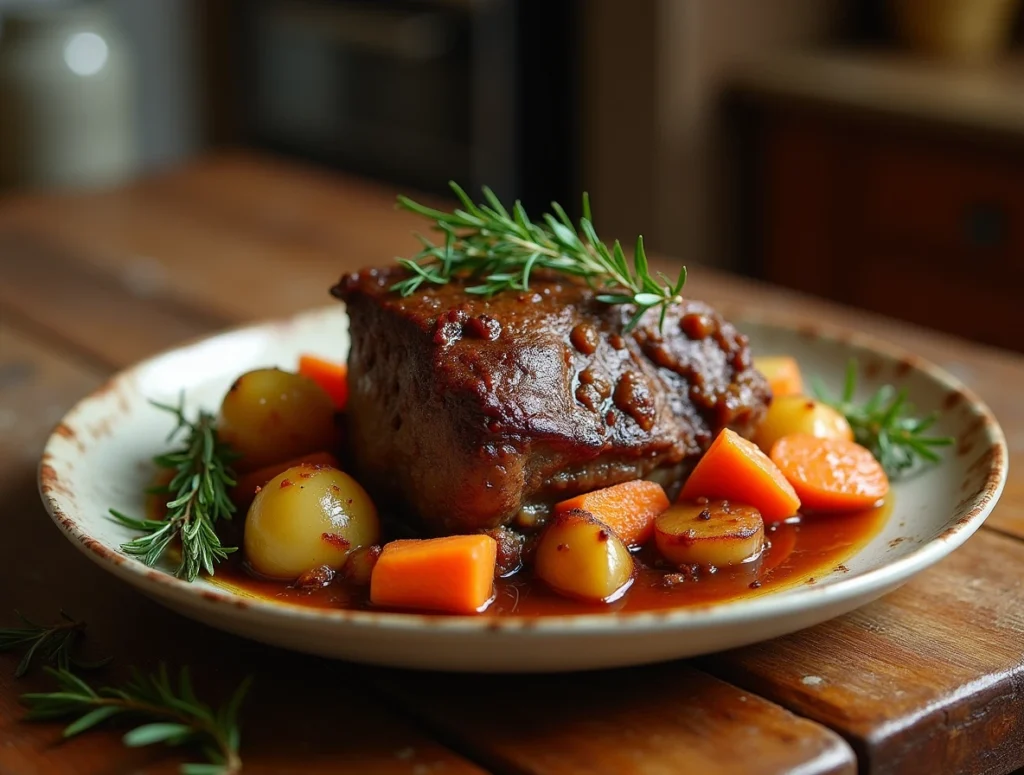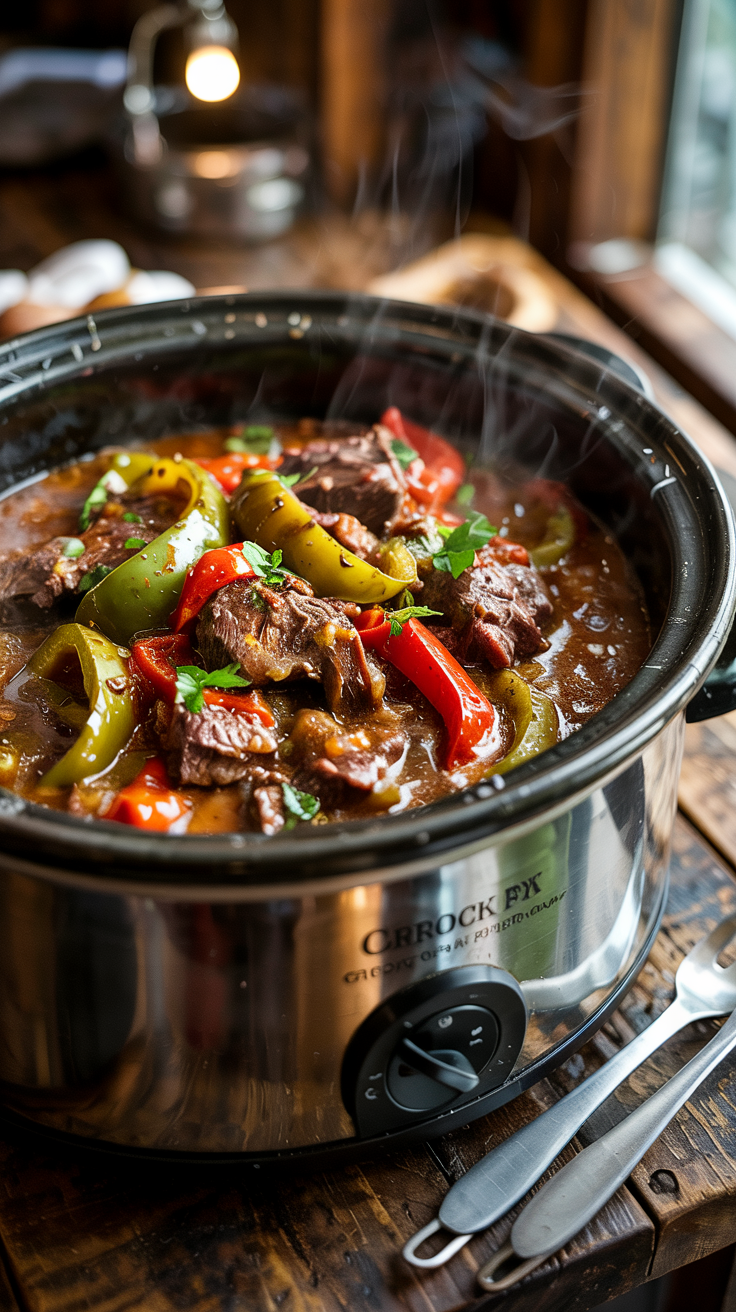Italian Pot Roast (Stracotto) Recipe
Italian Pot Roast (Stracotto) recipe is a traditional Italian dish that showcases the art of slow cooking. This hearty, comforting meal is beloved for its rich flavors, tender meat, and delicious, savory sauce. In Italy, Stracotto is often made for special occasions or family gatherings, and it has a reputation for being a perfect dish to feed a crowd.
Stracotto, which translates to “overcooked” in Italian, is all about the slow, meticulous cooking process that transforms a tough cut of beef into a melt-in-your-mouth experience. Unlike quick cooking methods, Stracotto requires time—typically 3 to 4 hours of slow braising or simmering on low heat—allowing the flavors to develop and the beef to become incredibly tender.
Table of Contents
The key to this dish lies in the quality of the ingredients. The most commonly used cut for Stracotto is the beef chuck roast, which is marbled with fat and connective tissue. These elements break down during the slow cooking process, infusing the meat with a deep, savory richness. Additionally, red wine, aromatic herbs, and vegetables such as onions, garlic, and carrots create the base for the flavorful sauce that accompanies the roast.
Unlike other pot roasts, Stracotto is often cooked in a Dutch oven or slow cooker to maintain an even temperature and retain moisture. The slow cooking method ensures that every bite is infused with the earthy flavors of the ingredients, making it the ultimate comfort food.
This dish is a staple in Italian households, particularly in regions like Tuscany, where slow-cooked meals are a long-standing tradition. It’s a perfect dish for colder months, family gatherings, or even a special Sunday dinner. Whether you’re an experienced home cook or a beginner, Stracotto is an easy-to-follow recipe that promises delicious results with just a few simple steps.
In this blog post, we will walk you through the process of making Stracotto, share some expert tips for achieving that melt-in-your-mouth tenderness, and offer suggestions for serving and customizing this classic Italian pot roast to your liking.
The Traditional Ingredients for Italian Pot Roast (Stracotto) Recipe
To create an authentic Italian Pot Roast (Stracotto), it’s essential to use high-quality ingredients that not only enhance the flavor of the dish but also contribute to the tender texture that defines this slow-cooked classic. Each ingredient has a specific role in ensuring the final dish is rich, flavorful, and melt-in-your-mouth tender. Let’s explore the key components that make Stracotto a quintessential Italian comfort food.
1. Beef Chuck Roast: The Perfect Cut for Slow Cooking
The star of the dish is the beef chuck roast, a cut known for its rich marbling of fat and connective tissue. While it may seem tough at first glance, this is precisely why it’s ideal for slow cooking. As the roast simmers over low heat for hours, the fat and collagen break down, turning the meat into something incredibly tender and flavorful. The beef chuck has the perfect balance of texture and taste, making it the ideal choice for Stracotto. It absorbs the flavors of the braising liquid while staying juicy and tender.
2. Red Wine: A Key Ingredient for Flavor and Tenderness
One of the hallmarks of an authentic Stracotto is the use of red wine. Traditionally, a dry, full-bodied wine such as Chianti, Cabernet Sauvignon, or Sangiovese is used to braise the beef. The wine imparts a deep, rich flavor to the roast, creating a savory base for the sauce. In addition to flavor, the acidity in the wine helps break down the fibers in the meat, further enhancing its tenderness. The wine also combines with other ingredients like broth and herbs to form a luscious gravy that coats the beef, adding another layer of complexity to the dish.
3. Aromatic Vegetables: Onions, Garlic, and Carrots
Aromatic vegetables are essential in creating the flavorful sauce that accompanies the Stracotto. Onions, when slow-cooked, release their natural sweetness, creating a subtle balance to the richness of the beef. Garlic adds a savory depth of flavor, infusing the roast with its robust, earthy notes. Carrots are often added for both flavor and texture, providing a mild sweetness that contrasts beautifully with the savory elements of the dish. In some variations of Stracotto, celery and leeks might also be included, adding even more layers of flavor to the sauce.
4. Fresh Herbs: Rosemary, Thyme, and Bay Leaves
Herbs are key to infusing Stracotto with its signature Italian flavor. Rosemary, with its piney, aromatic profile, is the most commonly used herb in Stracotto. Its strong flavor complements the richness of the beef while adding a fragrant note to the sauce. Thyme is another herb that pairs beautifully with beef, offering earthy, slightly floral undertones. Bay leaves are typically added during cooking to impart a subtle, slightly bitter flavor that enhances the overall dish. These herbs are usually tied together in a bundle (a bouquet garni) or simply tossed into the pot, infusing the dish with their aromatic essence throughout the slow cooking process.
5. Beef Broth: Creating a Rich Braising Liquid
To braise the beef, a good quality beef broth or stock is used, often mixed with the red wine. The broth serves as the cooking liquid, keeping the meat moist while it slow-cooks, and also forming the base for the delicious gravy that accompanies the roast. You can use homemade broth for the best flavor, but store-bought versions will work well, too. If you’re looking for extra depth, some recipes include a splash of tomato paste or canned tomatoes, which adds a slight tang and richness to the sauce.
6. Olive Oil: The Foundation of Flavor
As with most Italian dishes, olive oil plays a crucial role in building flavor. The roast is typically seared in olive oil before it’s braised, allowing the exterior of the meat to caramelize and develop a rich, golden crust. This not only adds flavor but also helps to lock in the juices and keep the meat tender as it cooks. Additionally, a drizzle of extra virgin olive oil is often added at the end of cooking to finish the dish and enhance its freshness.
These ingredients work in harmony to create a dish that is flavorful, aromatic, and comforting. The balance of savory, sweet, and acidic elements—combined with the slow cooking method—ensures that the Stracotto is tender and infused with layers of flavor. By using traditional Italian ingredients like beef chuck, red wine, herbs, and vegetables, you’ll be able to recreate this classic Italian pot roast recipe with ease and authenticity.
This section can seamlessly introduce the reader to the essential ingredients while reinforcing the idea that Stracotto is a dish that relies on the quality and balance of its components to achieve its beloved tenderness and rich flavor.
How to Cook Slow-Cooked Italian Pot Roast (Stracotto)
Cooking a Slow-Cooked Italian Pot Roast (Stracotto) requires patience and a bit of technique, but the results are well worth the effort. The slow cooking process helps transform the beef into a tender, melt-in-your-mouth roast, infused with the rich flavors of red wine, herbs, and vegetables. Here’s a step-by-step guide on how to cook this Italian classic to perfection.
1. Preparing the Beef: Seasoning and Searing
The first step in making a perfect Stracotto is to prepare the beef properly. Begin by selecting a beef chuck roast, which is the most common cut used for this dish due to its marbling and tenderness after slow cooking. Before cooking, pat the roast dry with paper towels to ensure a good sear.
- Season the Beef: Generously season the roast on all sides with salt and freshly ground black pepper. You can also rub in some garlic powder, onion powder, and dried herbs like thyme or rosemary for added flavor.
- Sear the Meat: In a large Dutch oven or heavy-bottomed pot, heat a couple of tablespoons of olive oil over medium-high heat. Once the oil is hot, place the roast into the pot and sear it on all sides until it develops a rich, golden-brown crust. Searing the beef not only helps to lock in its juices but also adds a deep, caramelized flavor that enhances the overall dish.
2. Preparing the Cooking Liquid: Red Wine, Broth, and Aromatics
Once the beef is seared, it’s time to prepare the flavorful cooking liquid that will braise the meat and make the sauce. This liquid is the key to achieving a tender roast with a rich, savory flavor profile.
- Deglaze with Red Wine: After removing the beef from the pot, pour a cup or two of red wine into the pot to deglaze. Use a wooden spoon to scrape up any browned bits stuck to the bottom of the pan, as these bits are packed with flavor. The wine will help lift these caramelized bits into the cooking liquid, which will later form the sauce.
- Add Broth and Aromatics: Add beef broth or stock to the pot, about 2-3 cups depending on the size of your roast. Then, add your aromatic vegetables like onions, garlic, and carrots. Toss in a few sprigs of fresh rosemary, thyme, and a couple of bay leaves for a traditional flavor base.
3. Slow Cooking the Pot Roast: Low and Slow is Key
Now that the beef and liquid are prepared, it’s time for the most crucial step: slow cooking. The goal is to cook the roast at a low temperature to allow the flavors to meld together and for the beef to become tender.
- In a Dutch Oven: After placing the roast back into the pot, cover it with a tight-fitting lid. Reduce the heat to low and allow the roast to simmer for about 3-4 hours, turning the meat halfway through if possible. The slow heat will help break down the tough fibers in the beef, making it incredibly tender.
- In a Slow Cooker or Crockpot: Alternatively, you can transfer the seared beef and cooking liquid to a slow cooker. Set it to low and cook for 6-8 hours. Slow cookers are an excellent option for hands-off cooking, as they maintain a consistent temperature for optimal braising.
- In the Oven: If you prefer to use the oven, place your Dutch oven in a preheated oven at 325°F (160°C). Cook for about 3-4 hours, or until the beef is fork-tender and easily shreds.
4. Checking for Doneness: The Perfect Tenderness
One of the key signs of a perfectly cooked Stracotto is the tenderness of the meat. After hours of slow cooking, the roast should be so tender that it pulls apart easily with a fork. When checking for doneness, carefully test the beef by poking it with a fork or knife—if it effortlessly pulls apart, it’s ready to be served.
- Test the Sauce Consistency: In addition to checking the meat, it’s important to assess the consistency of the sauce. The liquid should have thickened slightly from the collagen and fats released from the beef. If the sauce seems too thin, you can remove the roast and simmer the liquid uncovered for a few minutes to reduce and thicken it.
5. Resting the Roast: Let it Settle Before Slicing
Once the Stracotto is done cooking, it’s crucial to allow the roast to rest before slicing. This step ensures the juices are redistributed throughout the meat, making it even more tender and flavorful.
- Rest for 10-15 Minutes: Remove the roast from the pot and cover it loosely with foil. Let it rest for 10-15 minutes. While it’s resting, you can finish preparing the sauce if needed by reducing it or adding any final seasonings.
- Slice and Serve: After resting, slice the roast against the grain into thick slices, or shred it with a fork for a more rustic presentation. The sauce can be spooned over the top, and any vegetables can be served alongside or incorporated into the gravy.
By following these detailed steps, you’ll achieve a perfect Slow-Cooked Italian Pot Roast (Stracotto) every time. Whether you use a Dutch oven, slow cooker, or oven, the key is to cook the roast slowly and allow the flavors to develop over time. The result will be a tender, flavorful roast that is the epitome of Italian comfort food, perfect for any occasion.

Tips for Achieving Melt-in-Your-Mouth Tenderness
The key to an exceptional Slow-Cooked Italian Pot Roast (Stracotto) lies in achieving that perfect melt-in-your-mouth tenderness. To ensure the beef becomes tender and flavorful, there are a few techniques and tips you can follow throughout the cooking process. With the right approach, your pot roast will be so tender that it practically falls apart with a fork. Here are some expert tips to make sure your Stracotto turns out perfectly every time.
1. Choose the Right Cut of Beef: Beef Chuck Roast
To achieve melt-in-your-mouth tenderness, the cut of beef you use is crucial. The most common and ideal choice for Stracotto is the beef chuck roast. This cut is full of connective tissue and marbling, which are perfect for slow cooking. The fat and collagen in the chuck roast break down during the braising process, turning the meat into a tender, juicy roast. Other cuts like brisket or round roast can be used, but chuck roast remains the best choice for this dish due to its ideal texture and flavor.
2. Sear the Meat for Richness and Flavor
Before slow cooking, always take the time to sear the meat. Searing the roast on all sides creates a rich, golden-brown crust, which not only enhances the flavor but also helps seal in the juices. This Maillard reaction (the process that occurs when meat is browned) adds depth and complexity to the overall flavor profile. While it may seem like an extra step, searing the meat is a critical technique to ensure the final dish is flavorful and juicy.
- Tip: Use high-quality olive oil or vegetable oil to get a good sear without burning. Ensure the pot is preheated and hot before adding the beef to achieve a deep brown crust.
3. Cook Low and Slow: Patience is Key
Slow cooking at a low temperature is the secret to achieving that melt-in-your-mouth texture. The long cooking time allows the collagen in the meat to break down into gelatin, which makes the roast tender and juicy. High heat or fast cooking methods will not give the same results, as they don’t allow enough time for the connective tissue to break down properly.
- Tip: Use a Dutch oven, slow cooker, or oven set to a low temperature (around 275°F to 300°F) and let the roast cook for 3 to 4 hours in the oven or up to 8 hours in the slow cooker. Cooking it low and slow ensures the beef becomes incredibly tender without drying out.
4. Keep the Lid Tight: Prevent Moisture Loss
While the beef is cooking, it’s important to keep the lid tightly covered on the pot to prevent moisture from escaping. This helps maintain a consistent cooking environment, ensuring the roast stays moist throughout the slow cooking process. In the Dutch oven, the steam trapped inside will keep the meat from drying out, while also allowing the flavors to meld together. If cooking in a slow cooker, be sure to keep the lid on throughout the cooking process, as opening it can release heat and moisture.
- Tip: If you’re cooking in the oven, you can also cover the Dutch oven with parchment paper before putting on the lid, which adds an extra layer of moisture retention.
5. Use a Braising Liquid: Add Flavor and Tenderness
Braising your roast in a flavorful liquid is essential for ensuring tenderness and adding layers of taste. Red wine, beef broth, and aromatic herbs like rosemary and thyme infuse the meat with flavor while also helping break down the fibers in the beef. The acid in the wine further helps tenderize the meat, while the liquid keeps the roast moist and creates a luscious gravy.
- Tip: Ensure the roast is about halfway submerged in the braising liquid during cooking to guarantee it stays juicy. Add more broth or wine if necessary, but always maintain a flavorful base.
6. Let the Roast Rest: Redistribute the Juices
Once your roast is cooked to perfection, it’s important to let it rest for 10-15 minutes before slicing. Resting allows the juices inside the meat to redistribute evenly, ensuring that the roast remains moist and flavorful. Slicing immediately can cause the juices to escape, resulting in a drier roast.
- Tip: Tent the roast with foil while it rests to keep it warm, but don’t cover it too tightly to allow the steam to escape. This prevents the meat from becoming soggy while keeping it juicy.
7. Shred or Slice Against the Grain
When ready to serve, be sure to slice the roast against the grain (the direction of the muscle fibers). This ensures that the meat is more tender and easier to chew. Alternatively, for an even more tender result, shred the roast with a fork, allowing the fibers to break apart effortlessly.
- Tip: If you prefer shredded beef, you can easily shred the roast after it has rested. The meat will come apart with little effort, and the result will be an ultra-tender texture that is perfect for serving in sandwiches or alongside vegetables.
8. Use a Meat Thermometer for Perfect Timing
While slow cooking generally takes a long time, using a meat thermometer can help ensure the beef reaches the perfect internal temperature for maximum tenderness. For a chuck roast, the target temperature is usually 190°F to 200°F. This ensures that the collagen and connective tissues have broken down enough for a fork-tender roast.
- Tip: If you prefer a more precise level of doneness, use the thermometer to monitor the roast as it cooks to avoid overcooking or undercooking.
By following these tips, you’ll ensure that your Slow-Cooked Italian Pot Roast (Stracotto) turns out tender, juicy, and full of flavor. The combination of the right cut of beef, slow cooking, proper moisture, and careful resting will give you a melt-in-your-mouth roast every time.
Serving Suggestions for Your Italian Pot Roast (Stracotto)
The Slow-Cooked Italian Pot Roast (Stracotto) is a rich and flavorful dish that deserves to be served with the perfect sides to complement its melt-in-your-mouth tenderness. Whether you’re preparing this dish for a family dinner, special occasion, or a cozy meal, the way you serve it can elevate the entire dining experience. Here are some fantastic ideas for serving your Stracotto:
1. Serve with Creamy Mashed Potatoes
A classic pairing with any pot roast is creamy mashed potatoes. The smooth, buttery texture of mashed potatoes works perfectly to soak up the savory gravy from the roast, allowing each bite to be indulgent and comforting.
- Tip: For extra richness, you can use sour cream, cream cheese, or butter in your mashed potatoes. Add roasted garlic for a subtle depth of flavor that pairs beautifully with the roast.
- Alternative: If you’re looking for a lighter option, cauliflower mash is a great low-carb substitute for mashed potatoes while still offering a creamy texture to complement the beef.
2. Pair with Roasted Vegetables
Roasted vegetables are an excellent choice to serve alongside your Stracotto, adding color, flavor, and nutrition to the plate. Vegetables such as carrots, parsnips, onions, and potatoes take on a deliciously caramelized flavor when roasted, and their natural sweetness balances the savory richness of the roast.
- Tip: Toss your vegetables in olive oil, garlic, and fresh herbs like rosemary or thyme before roasting them in the oven for about 25-30 minutes at 400°F. For a perfect pairing, make sure they are roasted until golden brown and tender, creating a great contrast in textures with the tender roast.
3. Serve Over Polenta
For a truly authentic Italian touch, serve your Stracotto over a bed of creamy polenta. Polenta is a wonderful base that absorbs the juices from the pot roast and enhances its flavor. It’s also an excellent alternative to traditional mashed potatoes or pasta.
- Tip: To make the polenta extra creamy, stir in some butter and parmesan cheese as it cooks, which adds richness and depth. If you want to add some extra texture, you can let the polenta set in a pan and then slice it into squares before serving.
4. Pair with Fresh Italian Bread
No Italian meal is complete without a crusty loaf of Italian bread on the side. Whether you opt for a classic ciabatta or focaccia, the bread serves as the perfect vehicle for soaking up the savory gravy left on the plate.
- Tip: Toast the bread lightly for an added crunch, or serve it fresh with a drizzle of extra virgin olive oil for dipping. This will complement the tender roast beautifully and add an element of texture to the meal.
- Alternative: For a more rustic twist, garlic bread or herb-infused bread can add extra layers of flavor to your meal.
5. Pair with a Simple Salad
A light, fresh salad is a great way to balance the richness of the Stracotto. A salad made with mixed greens, arugula, spinach, or even endive offers a crisp contrast to the tender meat. Adding ingredients like cherry tomatoes, shaved parmesan, and a simple balsamic vinaigrette brings a zesty and refreshing element to the plate.
- Tip: For an extra touch, top your salad with toasted nuts (like walnuts or pine nuts) or a sprinkle of crumbled goat cheese for added texture and flavor.
- Alternative: If you’re looking for a heartier option, try a roasted beet salad with goat cheese and walnuts, which pairs wonderfully with the earthy flavors of the pot roast.
6. Serve with Italian-Style Pasta
For a more substantial meal, consider serving your Italian Pot Roast with a side of Italian pasta. A bowl of pappardelle, fettuccine, or rigatoni tossed in a bit of olive oil, garlic, and parmesan cheese can absorb the flavorful gravy from the pot roast and create a satisfying dish.
- Tip: Cook the pasta al dente and toss it with a bit of the braising liquid from the roast to infuse it with the rich flavors. You can also add a sprinkle of fresh parsley or basil to finish it off.
7. Complement with a Full-bodied Red Wine
The rich and savory flavors of Stracotto deserve a wine pairing that can stand up to its bold taste. A full-bodied red wine, such as Chianti, Barolo, or Brunello di Montalcino, is the perfect choice. The acidity and tannins in these wines help cut through the richness of the roast while complementing its deep, savory flavors.
- Tip: If you’re cooking with wine in the recipe, using the same wine for the pairing will create a more harmonious flavor profile.
8. Add a Touch of Fresh Herbs
Before serving, finish off the dish with a sprinkle of fresh herbs such as parsley, basil, or thyme. The fresh herbs will add a burst of color and a fragrant aroma that enhances the dish without overpowering the flavors of the roast.
- Tip: For added flavor, you can also drizzle a small amount of balsamic glaze over the finished dish for a touch of acidity that contrasts nicely with the richness of the pot roast.
By pairing your Slow-Cooked Italian Pot Roast (Stracotto) with any of these sides, you can create a balanced and memorable meal that showcases the flavors of the roast while offering a variety of textures and tastes. Whether you choose classic mashed potatoes, roasted vegetables, creamy polenta, or a fresh salad, these serving suggestions will elevate your Stracotto and ensure a satisfying meal every time.
Variations of Stracotto and How to Make it Your Own
While the Slow-Cooked Italian Pot Roast (Stracotto) has a rich and flavorful base, the beauty of this dish lies in its versatility. The traditional recipe can be easily customized to suit different tastes, dietary preferences, and regional variations. Here are some creative ways to tweak the classic Stracotto recipe and make it your own:
1. Choose Different Cuts of Meat
While the traditional Stracotto uses a cut like chuck roast or brisket for its rich, melt-in-your-mouth texture, you can experiment with other cuts of beef or even different meats entirely. Each cut has its own flavor and texture profile, which can give your dish a unique twist.
- Alternative Beef Cuts: If you prefer a leaner cut, try using round roast or sirloin. These cuts will still become tender when slow-cooked, though they may be slightly less fatty than chuck roast.
- Pork Version: For a lighter variation, you can use pork shoulder instead of beef. Pork shoulder has a similar fat content and tenderness when braised, and it brings a subtly sweet flavor to the dish.
- Lamb Version: If you’re in the mood for something more exotic, lamb shanks or lamb shoulder can be substituted for beef. The rich, gamey flavor of lamb pairs beautifully with the braising liquids and herbs used in Stracotto.
2. Adjust the Braising Liquid
The braising liquid plays a key role in developing the deep flavors of Stracotto, but you can adjust it to create different taste profiles. While red wine is a classic choice, experimenting with different liquids can add a new dimension to the dish.
- Wine Varieties: Instead of using Chianti or Barolo, try Cabernet Sauvignon, Merlot, or even a Zinfandel for a different flavor profile. Each wine will contribute a distinct taste—Cabernet Sauvignon, for example, offers a more robust flavor, while Merlot tends to be smoother and fruitier.
- Broth and Stock: For a more savory base, consider using beef broth, chicken stock, or vegetable stock instead of wine. These options are great for those who prefer a non-alcoholic version of Stracotto and can create a more pronounced meaty flavor in the braising liquid.
- Citrus Twist: For a refreshing twist, add some orange juice, lemon juice, or zest to the braising liquid. This will add a burst of acidity that balances out the rich flavors of the meat, creating a more complex and layered dish.
- Tomato-based Variation: For a more Mediterranean approach, include a can of crushed tomatoes or tomato paste in the braising liquid. The acidity of the tomatoes complements the meat and adds a slight tanginess to the sauce, which can also pair nicely with herbs like oregano or basil.
3. Experiment with Herbs and Seasonings
The herbs used in traditional Stracotto are often rosemary, thyme, and bay leaves, but you can adjust the seasoning to fit your tastes. By varying the herbs and spices, you can give the dish an entirely new flavor profile.
- Spicy Twist: If you enjoy a bit of heat, try adding crushed red pepper flakes or a touch of cayenne pepper to the braising liquid. This can give your Stracotto a spicy kick, complementing the richness of the beef.
- Herb Variations: While rosemary and thyme are classic, consider incorporating other herbs such as oregano, marjoram, or sage for a different aromatic experience. Basil can also be used for a more Italian-inspired flavor that pairs beautifully with the slow-cooked beef.
- Garlic and Onion: Though garlic and onion are typically used in Stracotto, you can experiment with shallots for a milder, sweeter flavor. Additionally, adding roasted garlic instead of fresh can impart a deeper, more caramelized taste to the dish.
4. Add Vegetables for a Complete One-Pot Meal
While Stracotto is typically served with side dishes, adding more vegetables to the pot can create a heartier, one-pot meal. The slow cooking process allows the vegetables to absorb the rich flavors of the braising liquid, resulting in a flavorful and filling dish.
- Root Vegetables: Adding root vegetables like carrots, parsnips, rutabagas, or turnips to the pot will enhance the dish’s flavor while providing additional texture. These vegetables absorb the braising liquid and become tender while adding sweetness and earthiness.
- Mushrooms: For a more earthy and umami-rich flavor, consider adding button mushrooms, cremini mushrooms, or porcini mushrooms to the braise. The mushrooms will soak up the savory juices and create a delicious complement to the beef.
- Potatoes: You can also include potatoes—either whole or chopped—directly in the pot. They’ll absorb the flavors of the beef and broth, creating a comforting and satisfying meal.
5. Add a Sweet Element
For a more unexpected flavor twist, try adding a sweet element to the Stracotto to balance the savory and rich flavors of the meat.
- Dried Fruits: Adding dried apricots, prunes, or raisins to the braising liquid can bring a touch of sweetness and complexity to the dish. The dried fruit will plump up and infuse the pot roast with a subtle sweetness that contrasts beautifully with the savory beef.
- Balsamic Vinegar or Honey: Drizzle a little balsamic vinegar or honey into the braising liquid towards the end of cooking. The sweetness of these ingredients balances the acidity and richness, creating a well-rounded flavor profile.
6. Make It a More Rustic or Refined Dish
- Rustic Version: For a more rustic, hearty dish, serve your Stracotto with the vegetables and braising liquid as is, without straining. You can keep the vegetables chunky, and the dish will feel homey and satisfying.
- Refined Version: For a more refined presentation, you can strain the braising liquid to create a smooth, glossy sauce. Serve the roast with finely chopped vegetables and herbs for a more elegant plating. You could also garnish the dish with a drizzle of olive oil or a sprinkle of freshly grated parmesan cheese for extra flavor and sophistication.
By exploring these variations, you can easily adjust the Slow-Cooked Italian Pot Roast (Stracotto) to suit your tastes and create a new twist on this classic Italian dish. Whether you’re experimenting with different cuts of meat, braising liquids, herbs, or vegetables, each variation offers an exciting opportunity to make this dish your own. The beauty of Stracotto lies in its adaptability, so feel free to get creative and discover your perfect version of this comforting and delicious meal.
Conclusion: Why You’ll Love This Slow-Cooked Italian Pot Roast (Stracotto)
In conclusion, the Slow-Cooked Italian Pot Roast (Stracotto) is more than just a meal—it’s a journey into the heart of Italian cooking, offering rich, comforting flavors that warm the soul. The beauty of Stracotto lies in its simplicity, yet it delivers a depth of flavor that comes from slow-braising tender cuts of meat with aromatic herbs and a rich braising liquid. Whether you’re looking for a traditional, family-style dinner or seeking a dish that’s easily adaptable to your preferences, this recipe provides a canvas for both creativity and authenticity.
A Tradition Worth Embracing
As you’ve learned, Stracotto is an enduring Italian tradition passed down through generations, celebrated for its melt-in-your-mouth tenderness and savory depth. With each bite, you’re not just tasting a meal but also experiencing a part of Italy’s rich culinary heritage. Whether you’re preparing it for a special Sunday dinner, a holiday gathering, or simply to enjoy on a chilly evening, this dish is perfect for sharing with loved ones. The joy of serving Stracotto comes not only from the flavors but from the cherished moments of gathering around the table to enjoy it together.
Easy Customization for Every Taste
One of the standout qualities of this dish is its versatility. While the classic recipe provides a solid foundation, there are endless opportunities to make it your own. You can experiment with different cuts of meat, herbs, braising liquids, and vegetables to create a version that suits your personal preferences. Whether you like your Stracotto with a splash of citrus, a hint of sweetness, or a spicy kick, the possibilities are endless. The slow cooking method ensures that the flavors meld together beautifully, no matter what variations you choose.
Perfect for Meal Prep and Leftovers
Stracotto is also an ideal dish for meal prepping and enjoying throughout the week. Its flavors deepen and improve over time, making it even more delicious the next day. Leftovers can be used for sandwiches, stews, or served alongside mashed potatoes or polenta for a comforting second meal. The braised meat can be easily reheated and still retain its tenderness, making it a time-saving dish that keeps on giving.
A Dish That Brings People Together
At its core, Stracotto is a dish made for sharing. Its comforting nature and tender texture are perfect for family dinners, special occasions, or even casual weeknight meals. It’s a great way to gather people around the table and share a hearty, flavorful meal that is both satisfying and memorable. Plus, with the variety of ways you can customize it, you can make this dish your own and create your unique version that everyone will love.
Final Thoughts
If you’re looking for a dish that is both comforting and full of flavor, the Slow-Cooked Italian Pot Roast (Stracotto) is an excellent choice. Whether you stick to the traditional recipe or experiment with your variations, you can’t go wrong with this slow-braised masterpiece. So gather your ingredients, fire up your slow cooker or oven, and prepare to indulge in a dish that brings warmth, tradition, and happiness to your dining table.
Did You Try Our Recipe?
There are no reviews yet. Be the first one to write one.






